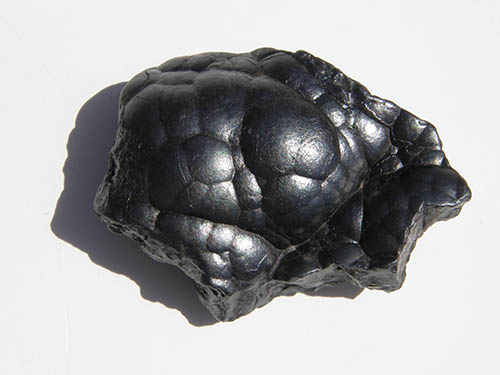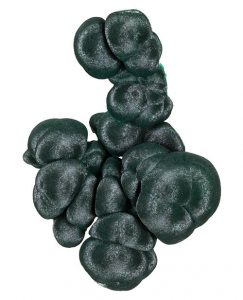
By Jim Brace-Thompson
The characteristic shape in which a crystal or crystal cluster forms is called its “habit”. While we often associate mineral crystals with perfect geometric shapes (like prismatic tourmaline, tabular barite, bladed kyanite, or cubic galena), minerals may take many other shapes as they crystalize and grow, particularly if they grow in dense clusters.
Exploring Habits
One such habit goes by the weird name of “reniform”. Reniform means “kidney-shaped”. A kidney is a curving, elongated bodily organ with lobes, similar in shape to the bean that bears its name. In mineralogy, the term reniform refers to minerals that grew as interlocking, rounded masses that look very much like a kidney. Such clusters may also be referred to by another weird phrase: “spheroidal aggregates”.
It all begins with a densely packed cluster of needlelike crystals. The crystals grow outward in a radiating pattern and end in rounded surfaces. Left to themselves, individual clusters might eventually form spheres, but they usually interlock and fuse with other crystal clusters that are growing nearby. The resulting, larger mass has a bumpy surface that looks like a group of spheres has been mashed together.
Surface Masses

Similar, but smaller, clusters form masses with a bumpy surface that resembles a bunch of grapes; these surfaces are referred to as “botryoidal”. Clusters that form much larger individual masses, on the other hand, are referred to as “mammillary”. These three habits tend to grade into each other, and I would be hard pressed to tell you where a botryoidal mineral mass becomes a reniform one! Geologists use very speci c measurements to delineate and differentiate such sediments as silt, sand, gravel, cobbles and boulders, but I have yet to find a speci c scale that measures the differences among botryoidal, reniform and mammillary structures. Apparently, like so much else in life, it’s very subjective and relative!
Many minerals may end up as reniform masses. Hematite displays the reniform habit really well, so that’s the mineral that is most often used to illustrate the term. Some other common reniform minerals you’ll see in the eld or at a gem show are malachite, chalcedony, prehnite and smithsonite. Many of these are also found as botryoidal and/or mammillary masses.
Author: Jim Brace-Thompson
 Founder and overseer of the AFMS Badge Program for kids.
Founder and overseer of the AFMS Badge Program for kids.
An inductee of the National Rockhound & Lapidary Hall of Fame within the Education Category.














